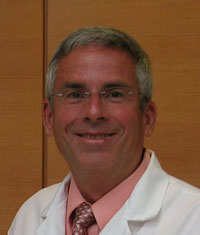 |
Steve Dixon, M.D. |
Dr. Dixon and his 29-person team care for the roughly 19,000 rats, mice and other animals used for research on the UNMC campus. They ensure the animals are maintained, treated and used humanely.
“We’re able to contribute to improved human health and relieve human suffering by using research animals,” Dr. Dixon said. “Animals have also benefited from animal research. We now have many vaccines for animals, such as rabies and distemper, that were originally developed by using animals in research.”
One example Dr. Dixon mentioned of how research animals helped prevent the suffering of tens of thousands of children worldwide was the development of the Blalock-Taussig shunt procedure to treat Tetralogy of Fallot, also known as blue baby syndrome.
In 1944, a Johns Hopkins University team that included legendary surgical technician Vivien Thomas, surgeon Alfred Blalock, M.D., and pediatric cardiologist Helen Taussig, M.D., developed the treatment for the disease, which is a congenital heart defect that affects normal blood flow through the heart and lungs.
The defect causes cyanosis, or bluish tint to the skin, lips and fingernails. Before the shunt development, babies with the disease lived as invalids and had a short life expectancy.
The team developed the shunt procedure by first successfully testing it on a pig.
To further his point, Dr. Dixon noted that seven of the past 10 Nobel Prizes in medicine have relied at least in part on using animals in research.
In the early 1970s during Dr. Dixon’s first years in the profession, he worked on a laser safety research team while stationed in Philadelphia in the U.S. Army.
“The team laid a lot of the ground work used for today’s laser photocoagulation treatment for eye diseases such as advanced diabetic retinopathy and retinal detachment,” Dr. Dixon said. “It’s the result of taking basic research and translating it to improve human health.”
In 1994, he worked as a team member to provide donor pig livers that UNMC surgeons and physicians used to save a man’s life.
A procedure called extracorporeal liver perfusion temporarily sustained the life of a critically ill 22-year-old Blair man until a donor liver was found.
The pig liver, which remained outside the patient’s body, was connected through an apparatus of tubing and pumps to provide temporary liver function.
Dr. Dixon recalled how grateful the family was for keeping their son alive until a donor liver was found.
“To me, that was really exciting to be able to assist in offering that option to someone who was dying,” Dr. Dixon said.